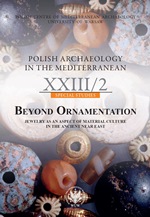Jewelery manufacture in the Kura-Araxes and Bedeni cultures of the southern Caucasus: analogies and distinctions for the reconstruction of a cultural
Jewelery manufacture in the Kura-Araxes and Bedeni cultures of the southern Caucasus: analogies and distinctions for the reconstruction of a cultural
Author(s): Eleonora CarminatiSubject(s): Archaeology
Published by: Wydawnictwa Uniwersytetu Warszawskiego
Keywords: jewellery; manufacture; southern Caucasus; Early Bronze Age; Bedeni; Kura-Araxes
Summary/Abstract: Jewellery manufacture by the Kura-Araxes and Bedeni cultures of the Late Chalcolithic– Early Bronze Age (mid 4th/3rd millennium BC) in the southern Caucasus is defined through several analogies as well as differences. Kura-Araxes jewellery is rather modest in production, usually made of copper or arsenical copper alloy. It is found in burials of an egalitarian-based society. The transition to the Bedeni phase is characterized by major innovations, illustrating marked cultural discontinuity: jewellery is frequently made of precious metals and occurs in wealthy burials that can be associated with apparent leaders of the community. Jewellery assemblages are rich and the working of some pieces so remarkable that they are veritable works of art. At the same time new techniques, probably acquired from the south (Mesopotamia and Anatolia), were introduced. This analysis will provide a different insight into this transitional phase, concentrating on the parallels and differences in shape, technology, use and selection of materials and artisan skills for the manufacture of jewellery. Consequently, some of the main social and economic settings of the Kura- Araxes and Bedeni cultures will be examined and compared.
Journal: Polish Archaeology in the Mediterranean
- Issue Year: 2/2014
- Issue No: XXIII
- Page Range: 161-186
- Page Count: 16
- Language: English

